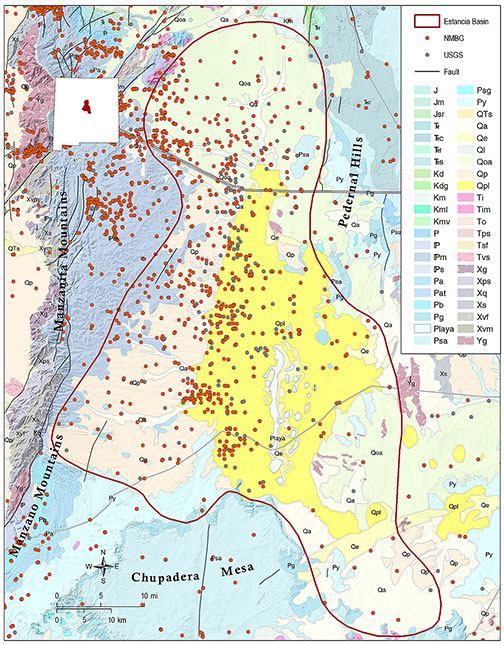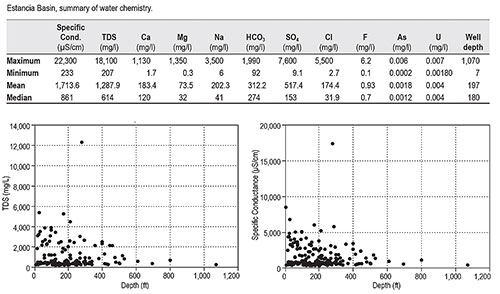
Overview of Fresh and Brackish Water Quality - Estancia Basin


The Estancia Valley is a relatively flat-floored, closed physiographic basin with internal drainage, occupying ~2,000 square miles in central New Mexico. The valley, most of which lies within Torrance County, is bounded to the west by the Manzano Mountains, to the east by the Pedernal Hills, and to the south by Chupadera Mesa. The northern margin of the basin is less well-defined, merging with a high plateau area in southern Santa Fe County (Meinzer, 1911; Smith, 1957; White, 1994). Highest elevations in the Estancia Valley (>9,000 feet) occur along the western rim of the watershed, on the east flank of the Manzano Mountains. Lowest elevations (~5,900 feet) are found along the central topographic axis of the basin, where a north-south trending series of playas formed by deflation are incised into the valley floor (Bachhuber, 1982). Because the Estancia Valley is a topographically-closed basin, the only outlet for precipitation that falls within the basin boundaries is by evapotranspiration, primarily from the playa lakes.
The Estancia Basin may be viewed as either a structural basin, containing mostly Paleozoic rock deformed by several tectonic events from late Paleozoic through Tertiary time; or as a Quaternary depositional basin. This report focuses on the Quaternary basin, which extends beyond the margins of the underlying structural basin (Broadhead, 1997). Regional dip of Paleozoic strata is generally eastward. Pennsylvanian-age Madera Limestone is exposed at the surface in western Torrance County, and Quaternary sediment overlies progressively younger Permian strata from west to east, including Abo and Yeso redbeds and gypsum, and middle-Permian Glorieta Sandstone along the eastern margin of the basin (Smith, 1957).
The Quaternary depositional basin is defined by the aerial extent of Quaternary valley fill, which consists of alluvial material, lake and dune deposits, and recent stream sediment. The valley-fill material reaches a maximum thickness of ~400 feet in the center of the valley, and thins to a feather edge along the margins (White, 1994). The valley fill is the principal aquifer for irrigation, livestock, and domestic and community water supply in the Estancia Valley. Groundwater flows from the basin margins to the area around Willard, where both the water table and land surface are at their lowest elevation (Smith, 1957; Titus, 1973). Along the western margin of the basin, groundwater is stored in solution-enlarged fractures and karstic conduits of the Madera limestone (Titus, 1980). The Glorieta sandstone also provides water for irrigation east of Moriarty (Lewis and West, 1995).
The mineral content of groundwater in the valley-fill aquifer increases from west to east. West of Highway 41 the water is generally satisfactory for irrigation, stock, and domestic and community water supply. East of the highway, water quality rapidly deteriorates, and is generally unsatisfactory for irrigation or human consumption (Smith, 1957). The interface between fresh and saline water is relatively sharp, occurring over a distance of less than 3 miles east of Highway 41. Water from some wells south of Moriarty has historically shown a significant increase in specific conductance, indicating a westward migration of the freshwater-saltwater interface within the valley-fill aquifer (White, 1994).
Data coverage for the Estancia Basin is substantial, with 561 total data points. Our records show that groundwater in the basin is somewhat brackish, with a mean TDS concentration of almost 1,300 mg/l. However, this mean value is influenced by water samples collected from three wells located in the central basin playa area with TDS >12,000 mg/l. The median TDS value of 614 mg/l may be more representative of basinwide water quality.
The valley-fill aquifer contains what appear to be significant brackish water resources near the center of the basin. Brackish water is probably also present in the underlying Paleozoic bedrock, although with an average well depth of just 197 feet, that potential resource remains unexplored.
This project is funded by the New Mexico Environment Department, Drinking Water Bureau, under Source Water Protection.
For more information:
see: Overview of Regional Brackish Water Assessments
or contact:
Lewis Land — Hydrogeologist, lland@nckri.org
References
- Land, Lewis, 2016, Overview of Fresh and Brackish Water Quality in New Mexico - Estancia Basin, Projects Summary Sheet.
- Land, Lewis, 2016, Overview of Fresh and Brackish Water Quality in New Mexico, New Mexico Bureau of Geology Mineral Resources, Open-file Report, v. 0583, pp. 55.



